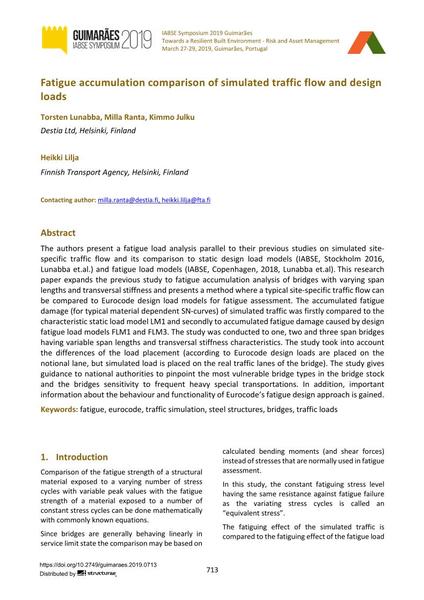Fatigue accumulation comparison of simulated traffic flow and design loads

|
|
|||||||||||
Bibliographic Details
| Author(s): |
Torsten Lunabba
(Destia Ltd, Helsinki, Finland)
Milla Ranta (Destia Ltd, Helsinki, Finland) Kimmo Julku (Destia Ltd, Helsinki, Finland) Heikki Lilja (Finnish Transport Agency, Helsinki, Finland) |
||||
|---|---|---|---|---|---|
| Medium: | conference paper | ||||
| Language(s): | English | ||||
| Conference: | IABSE Symposium: Towards a Resilient Built Environment Risk and Asset Management, Guimarães, Portugal, 27-29 March 2019 | ||||
| Published in: | IABSE Symposium Guimarães 2019 | ||||
|
|||||
| Page(s): | 713-720 | ||||
| Total no. of pages: | 8 | ||||
| DOI: | 10.2749/guimaraes.2019.0713 | ||||
| Abstract: |
The authors present a fatigue load analysis parallel to their previous studies on simulated site- specific traffic flow and its comparison to static design load models (IABSE, Stockholm 2016, Lunabba et.al.) and fatigue load models (IABSE, Copenhagen, 2018, Lunabba et.al). This research paper expands the previous study to fatigue accumulation analysis of bridges with varying span lengths and transversal stiffness and presents a method where a typical site-specific traffic flow can be compared to Eurocode design load models for fatigue assessment. The accumulated fatigue damage (for typical material dependent SN-curves) of simulated traffic was firstly compared to the characteristic static load model LM1 and secondly to accumulated fatigue damage caused by design fatigue load models FLM1 and FLM3. The study was conducted to one, two and three span bridges having variable span lengths and transversal stiffness characteristics. The study took into account the differences of the load placement (according to Eurocode design loads are placed on the notional lane, but simulated load is placed on the real traffic lanes of the bridge). The study gives guidance to national authorities to pinpoint the most vulnerable bridge types in the bridge stock and the bridges sensitivity to frequent heavy special transportations. In addition, important information about the behaviour and functionality of Eurocode’s fatigue design approach is gained. |
||||
| Keywords: |
bridges fatigue Eurocode traffic loads steel structures traffic simulation
|
||||
